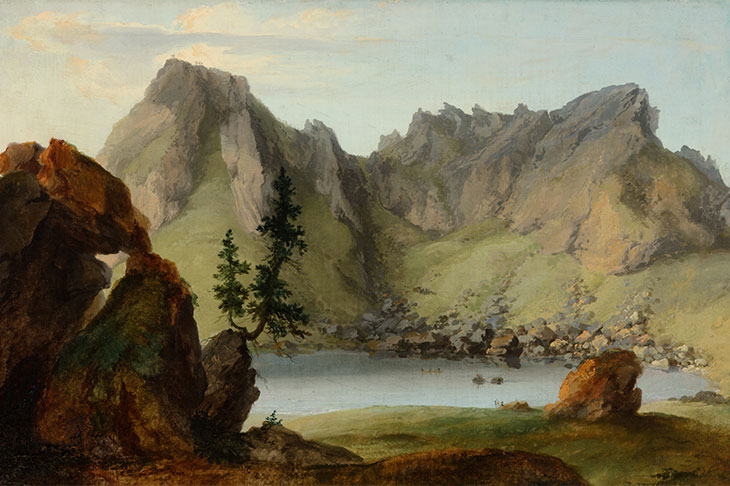A round-up of the best works of art to enter public collections recently
University of Texas at Dallas
The Barrett Collection of Swiss art
This remarkable gift to the University of Texas at Dallas, comprising more than 400 works collected by Richard Barrett and his late wife Nona, has been described by Richard Brettell, the director of the university’s Edith O’Donnell Institute of Art History, as ‘the most important collection of Swiss art ever formed outside of Switzerland’. It includes works ranging from the late 14th to mid 20th century – by artists including Ferdinand Hodler, Caspar Wolf, Angelica Kauffman and Jean-Étienne Liotard. The gift will be housed in a new museum, named after the Barretts, which is set to open in the next few years.

Ulysses on the Island of Circe (1793), Angelica Kauffman. University of Texas at Dallas
J. Paul Getty Museum, Los Angeles
Christ as the Man of Sorrows (1520–30), Quentin Metsys
A pioneer of the Antwerp School at the start of 16th century, Quentin Metsys played a key role in reviving the precise realism and attention to the effects of light that had characterised Flemish painting of the previous century – yet his work also shows the influence of Italian quattrocento painters like Leonardo. This graphic depiction of Christ evinces the artist’s talent for devotional portraiture. Before its recent acquisition by the museum, the work had remained in private hands, unknown to art historians, for centuries. The Getty Research Institute, meanwhile, also made an important acquisition last month – a collection of rare books, prints, and manuscripts related to the culinary arts,

Christ as the Man of Sorrows (1520–30), Quentin Metsys. J. Paul Getty Museum, Los Angeles
Mauritshuis, The Hague
Merry Company on a Terrace (c. 1616–17), Willem Buytewech
Though Willem Buytewech was well known in Haarlem in the early 17th century, only six oil paintings by the artist have survived; this acquisition by the Mauritshuis is one of his finest. Alongside Frans Hals, Buytewech was a key figure in the early development of Dutch genre painting – one only has to glance at this group of fashionable, flirtatious youths, cavorting in their finery on the terrace, to understand why his peers affectionately christened him ‘Witty Willem’.

Merry Company on a Terrace (c. 1616–17), Willem Buytewech. Mauritshuis, The Hague
Staatliche Kunsthalle Karlsruhe
Portrait, probably of the Marquis of Marigny (1753), Jean Marc Nattier
One of the most celebrated French portraitists of his day, Jean Marc Nattier only produced a small number of pastels in his career – over a period of around a decade from 1744, after he had already secured his fame as the painter to Queen Marie Leczinska. However, his works in the medium were widely praised; one was even described by a critic as ‘surpassing all [the works] he has made in oil’. This painting, which probably depicts the Marquis of Marigny, is one of only nine surviving pastel portraits of men by Nattier.

Portrait, probably of the Marquis of Maurigny (1753), Jean Marc Nattier. Staatliche Kunsthalle Karlsruhe
Nationalmuseum, Stockholm
View of Algiers behind the ramparts (c. 1840), Niels Simonsen
Celebrated as a battle painter in his early career, the Danish artist Niels Simonsen reinvented himself as a landscape artist after extensive excursions throughout Europe and further afield in the late 1830s and early ’40s. This picturesque landscape records a moment during Simonsen’s travels in Algeria.

View of Algiers (c. 1840), Niels Simonsen. Photo : Galerie Michel Descours
Morgan Library & Museum, New York
Bathers (1884–85), Pierre-Auguste Renoir
At nearly a metre and a half in length, this large-scale study offers a key insight into the compositional development of the artist’s major painting, The Large Bathers (1884–87). The drawing has not been exhibited in public before now. Earlier this month, the Morgan also acquired 11 drawings by five major African-American artists from the southern USA.

Bathers (1884–85), Pierre-Auguste Renoir. Morgan Library & Museum, New York. Photo: Graham S. Haber
Indianapolis Museum of Art
Lunch service (c. 1863), Sèvres manufactory
This lunch service follows a model designed for the Sèvres porcelain factory by Hyacinthe Régnier, who was inspired by Chinese examples. Purchased by the Indianapolis Museum of Art from Christie’s Paris in late November, it bolsters the museum’s collection of European decorative arts, while also providing a point of comparison with its strong holdings of Chinese porcelain.

Lunch service (1863), Sèvres manufactory. Indianapolis Museum of Art; © Christie’s Images Ltd, 2018.
Unlimited access from just $16 every 3 months
Subscribe to get unlimited and exclusive access to the top art stories, interviews and exhibition reviews.














![Masterpiece [Re]discovery 2022. Photo: Ben Fisher Photography, courtesy of Masterpiece London](http://www.apollo-magazine.com/wp-content/uploads/2022/07/MPL2022_4263.jpg)
It’s time for the government of London to return to its rightful home